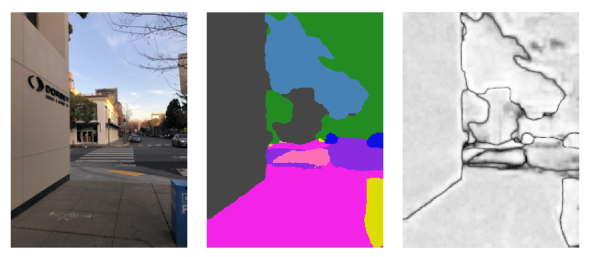瞭解如何在自家應用程式中使用 Scene Semantics API。
透過場景語意 API,開發人員可以提供機器學習模型的即時語意資訊,瞭解使用者周遭的場景。當您提供戶外場景的圖片時,API 會針對每個像素傳回一組實用的語意類別標籤,例如天空、建築物、樹木、道路、人行道、車輛、人物等。除了像素標籤之外,場景語意 API 還會為每個像素標籤提供信心值,並提供簡單易用的查詢方式,可查詢特定標籤在戶外場景中的盛行率。
從左至右,分別為輸入圖片、像素標籤的語意圖片,以及對應的信心圖片:

必要條件
請務必先瞭解基本 AR 概念,並瞭解如何設定 ARCore 工作階段,再繼續操作。
啟用場景語意
在新的 ARCore 工作階段中,確認使用者的裝置是否支援 Scene Semantics API。由於處理效能受限,並非所有 ARCore 相容裝置都支援 Scene Semantics API。
為了節省資源,ARCore 預設會停用場景語意。啟用語意模式,讓應用程式使用 Scene Semantics API。
Java
Config config = session.getConfig(); // Check whether the user's device supports the Scene Semantics API. boolean isSceneSemanticsSupported = session.isSemanticModeSupported(Config.SemanticMode.ENABLED); if (isSceneSemanticsSupported) { config.setSemanticMode(Config.SemanticMode.ENABLED); } session.configure(config);
Kotlin
val config = session.config // Check whether the user's device supports the Scene Semantics API. val isSceneSemanticsSupported = session.isSemanticModeSupported(Config.SemanticMode.ENABLED) if (isSceneSemanticsSupported) { config.semanticMode = Config.SemanticMode.ENABLED } session.configure(config)
取得語意圖像
啟用場景語意後,即可擷取語意圖像。語意圖片是 ImageFormat.Y8 圖片,其中每個像素都對應至由 SemanticLabel 定義的語意標籤。
使用 Frame.acquireSemanticImage() 取得語意圖像:
Java
// Retrieve the semantic image for the current frame, if available. try (Image semanticImage = frame.acquireSemanticImage()) { // Use the semantic image here. } catch (NotYetAvailableException e) { // No semantic image retrieved for this frame. // The output image may be missing for the first couple frames before the model has had a // chance to run yet. }
Kotlin
// Retrieve the semantic image for the current frame, if available. try { frame.acquireSemanticImage().use { semanticImage -> // Use the semantic image here. } } catch (e: NotYetAvailableException) { // No semantic image retrieved for this frame. }
視裝置而定,輸出語意圖像的時間應在工作階段開始後的 1 到 3 個影格後。
取得安心圖片
除了提供每個像素的標籤的語意圖像外,API 還會提供對應像素信心值的信心圖像。信心圖片是 ImageFormat.Y8 圖片,其中每個像素都對應至 [0, 255] 範圍內的值,並與每個像素的語意標籤相關聯的機率相符。
使用 Frame.acquireSemanticConfidenceImage() 取得語意信心圖像:
Java
// Retrieve the semantic confidence image for the current frame, if available. try (Image semanticImage = frame.acquireSemanticConfidenceImage()) { // Use the semantic confidence image here. } catch (NotYetAvailableException e) { // No semantic confidence image retrieved for this frame. // The output image may be missing for the first couple frames before the model has had a // chance to run yet. }
Kotlin
// Retrieve the semantic confidence image for the current frame, if available. try { frame.acquireSemanticConfidenceImage().use { semanticConfidenceImage -> // Use the semantic confidence image here. } } catch (e: NotYetAvailableException) { // No semantic confidence image retrieved for this frame. }
輸出信心圖片的時間,應在工作階段開始後約 1 到 3 個影格後 (視裝置而定)。
查詢語意標籤的像素百分比
您也可以查詢目前影格中屬於特定類別 (例如天空) 的像素比例。這項查詢比傳回語意圖像,並針對特定標籤執行逐像素搜尋更有效率。傳回的係數是 [0.0, 1.0] 範圍內的浮點值。
使用 Frame.getSemanticLabelFraction() 取得特定標籤的分數:
Java
// Retrieve the fraction of pixels for the semantic label sky in the current frame. try { float outFraction = frame.getSemanticLabelFraction(SemanticLabel.SKY); // Use the semantic label fraction here. } catch (NotYetAvailableException e) { // No fraction of semantic labels was retrieved for this frame. }
Kotlin
// Retrieve the fraction of pixels for the semantic label sky in the current frame. try { val fraction = frame.getSemanticLabelFraction(SemanticLabel.SKY) // Use the semantic label fraction here. } catch (e: NotYetAvailableException) { // No fraction of semantic labels was retrieved for this frame. }

